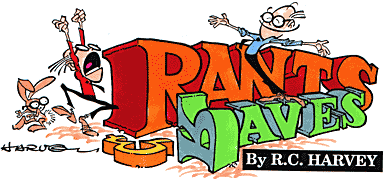 |
||||||||||||||
Opus 401 (February 29, 2020). Having shorted Editoonery last time, we pile it on now, just in time to prepare you for Super Tuesday. For this exclusive Political Posting, we’ve scoured the landscape for a selection of editorial cartoons reflecting events of the past 45 days or so—namely, the Trumpet’s impeachment and trial by the Senate, the Iowa caucuses, Trump’s State of the Union address, and the Superbowl half-time scandal, reviews of a couple collections of hard-hitting editoons—and more, of course. Inspired by the political cartoons, the Happy Harv also fulminates on his own about the debates, Bernie and the insufferable Iowa caucuses, and New Hampshire primary and other rampant injustices. But it’s not all frothing-at-the-mouth politics. Not everyone loves political “discussions,” so throughout the Editoonery section, we’ve sprinkled some ordinary but inspiring gag cartoons, a historical note or two plus the New Yorker anniversary covers. Also—Katy Keene is back! And with her, cheesecake! Finally, at the end, obits for Victor Gorelick and Claire Bretecher. In order to assist you in wading through all this plethora, we’re listing Opus 401's contents below so you can pick and choose which items you want to spend time on. Here’s what’s here, by department, in order, beginning with the news of the day (followed by POLITICS!)—:
NOUS R US Dan DiDio Fired at DC Ohman Promoted Stripping with Big Nate and Funky Winkerbean Wonder Woman Back on the Big Screen Astonishing News : Flash Gordon Original To Be Auctioned How Truth Is Twisted on Social Media: Bernie Sanders Slandered Politics: Part the First Cartoon Break: Debate Toons Politics: Part the Second Acquitting a President Crowns a King
FUNNYBOOK FAN FARE Archie and Katy Keene Machine Girl
BOOK MARQUEE Front Lines: Political Cartooning and the Battle for Free Speech The Trump Years: This Is the End TRUMPERIES The Idiotic Antics of Our Self-Aggrandizing Buffoon in Chief
EDITOONS The Mock in Democracy Impeachment, State of the Union, Caucuses, Superbowl et al With Interludes of Gag Toons & New Yorker Covers
NEWSPAPER COMICS PAGE VIGIL The Bump and Grind of Daily Stripping
PASSIN’ THROUGH Archie’s Victor Gorelick Claire Bretcher
QUOTE OF THE MONTH If Not of A Lifetime “Goddamn it, you’ve got to be kind.”—Kurt Vonnegut
Our Motto: It takes all kinds. Live and let live. Wear glasses if you need ’em. But it’s hard to live by this axiom in the Age of Tea Baggers, so we’ve added another motto: Seven days without comics makes one weak. (You can’t have too many mottos.)
And in the same spirit, here’s—: Chatter matters, so let’s keep talking about comics.
And our customary reminder: don’t forget to activate the “Bathroom Button” by clicking on the “print friendly version” so you can print off a copy of just this installment for reading later, at your leisure while enthroned. Without further adieu, then, here we go—:
NOUS R US Some of All the News That Gives Us Fits
DiDIO GOES ComicBook.com has learned that Dan DiDio is no longer with DC Comics; and DC has confirmed the news. As this is written, DC had not yet issued a statement publicly, though it's likely coming soon. But BleedingCool.com asserts that DiDio was fired; that report begins a couple paragraphs down the scroll. It's the end of an era at DC Comics: DiDio was best known for overseeing multiple initiatives that pushed massive awareness of the brand, with storylines and titles including Infinite Crisis, 52, the New 52 relaunch, and DC Rebirth, as well as other stories like Before Watchmen and Doomsday Clock. DiDio has served as co-publisher alongside superstar artist Jim Lee for the last decade, being anointed as one of the figureheads of DC Comics by then-president Diane Nelson. Bleeding Cool now understands that yes, DiDio was fired by Warner Bros one morning last month in their Burbank offices, and he left the building straight away. The Bleeding Cool report follows—: “I am told by sources close to the situation that he was fired for cause, for 'fostering a poor work environment' – as evidenced, as we previously stated, by significant departures at the publisher by editors.” Dan DiDio has a reputation among some of being a micro-manager, among others, for being very involved in projects. And DC Comics was heading towards a big change in its publishing programme – one aspect of which was the much-rumoured 5G – or Generation Five— which would have seen DC's major figures Bruce Wayne, Clark Kent, Diana and more aged out and replaced with new characters taking the roles of Superman, Batman and Wonder Woman as part of the new DC Timeline. And some folk at DC Comics were very much against this. But opposition never worried Dan, after all he was at constant odds with the direction the company line was pushed for pretty much his entire career as Publisher, and was always was striving to put comics first, as he saw it. But in recent months, there seemed to be editorial backtracks on the direction given, details changes and a general sense of frustration that the clock was ticking and that nothing was being done. We saw a rapid departure in DC editorial of Pat McCallum, Alex Antone, Molly Mahan, Rob Levin and others. Could this have been a factor? Certainly, DiDio's departure was a surprise – to him as it was for everyone else. I understand that it was internally announced at a series of small staff meetings at Burbank. Though no one seems to have told the executives attending ComicsPRO, who had to read about it on Bleeding Cool on their mobile phones – and who sharply exited the conference as a result. Jim Lee is the remaining Publisher and CCO at DC, and so will be steering the ship for the foreseeable future. Is it too late to change the upcoming C2E2 panel Meet The Publishers to the singular now?
OHMAN PROMOTED Sacramento Bee editorial cartoonist Jack Ohman has been promoted to deputy opinion editor. In his expanded role, Ohman, who won the Pulitzer for editooning in 2016, will write more editorials and columns focused on local and state issues. He will also help edit the Bee’s California Forum opinion section. Ohman barely escaped oblivion in 2012 when the Bee hired him from the Portland Oregonian, which was rumored to be on the brink of downsizing by eliminating Ohman, who’d been there since 1983.
STRIPPING Big Nate, the popular comic strip and children’s book character by Lincoln Peirce (pronounced “purse”), is slated to become an animated television series on Nickelodeon. Nate also appears in at least six novels (actually, more like picture books aimed, somewhat, at juvenile readers) patterned after Jeff Kinney’s Wimpy Kid books. (Peirce and Kinney have been friends for a long time, and Kinney took Peirce under his wing and showed him the rope to pull to get published.) Funky Winkerbean, a newspaper strip since 1972, is one of the few comic strips in which its characters have aged. The ninth volume of the collected Funky Winkerbean, containing strips from 1996 through 1998, has now been published. In the seventh volume, which included 1992, Tom Batiuk, Funky’s father, shifted the time in the strip and made the characters “age” out of high school, which is where they all started. Now they’re all 20-30 years older and scarcely recognizable as the characters they were when teenagers. Batiuk has also introduced new characters. He runs little continuities of about a week, going from one character to another. I no longer know which of them I’m looking at. And Batiuk, who gained some notoriety several years ago when one of his characters died of cancer (and the strip showed how the characters dealt with this tragedy), likes to take up “serious” “life” topics. Last fall, for instance, one of his characters died; it took about 30-45 days—including weeks where no one says anything; they just look mournful.
WONDER WOMAN BACK ON THE BIG SCREEN Entertainment Weakly’s March double-issue starts by devoting its cover to Gal Gadot in the gloriously shiny Wonder Woman costume she wears in the
forthcoming WW flick. And then makes up for the wardrobe sacrilege by putting H.G. Peter’s Wonder Woman on the Table of Contents page. (Miraculously, EW gives Peter credit.) Then during the article itself, a two-half-page spread presents an array of comicbook Wonder Woman that traces the history of her costume (which we’ve posted here, in the corner of your eye). The article is not so much about the movie as it is about its actors and Wonder Woman’s new metal costume with wings made “from a spine-straining carbon fiber weighing upwards of 44 pounds.” Oh—and Steve Trevor is back from the dead (?).
ASTONISHING NEWS I didn’t think it possible. The original art for Alex Raymond’s first Flash Gordon strip is still extant. And it will be auctioned off on March 31 by Profiles in History, which claimed this is the first time this artwork is for sale. So who owns it? The auction will also offer another Raymond creation, Jungle Jim, which was Flash Gordon’s “topper”: it was published as the top two tiers of a whole page, the rest of which was devoted to Flash’s adventures.
HOW THE TRUTH IS TWISTED ON SOCIAL MEDIA In the interest of a greater public awareness, we have a sample of Social Media Garbage. It’s an attack on Bernie Sanders, whom I don’t like at all (ever) so you’d think I’d applaud this effusion; but no, I don’t. Here’s the Garbage (in italics)—: Bernie Sanders is truly special. He never held a job until he was finally elected mayor at age 53. He lived off of welfare and four different women had a child out-of-wedlock with one and the three marriages did not work out. In all his years in the Senate, he introduced 364 bills; 3 passed. Two of those were to name post offices. If you want to know what kind of leader Bernie is, go to Wikipedia, it’s a long report. Yes, and if you wade through it, you learn that Sanders was elected mayor at age 40, not 53; and he was re-elected three times before deciding to run for Congress. He has been married twice, his first marriage (to a college sweetheart) ending in divorce after a couple years; his second marriage is still intact after 32 years. His out-of-wedlock child was born by the girlfriend he acquired after his first marriage; they never married. He’s been in Congress since 1991, the year he was elected to the House of Representatives, where he stayed until being elected a senator in 2007. He apparently has held no other regular job; his early adult years were spent in feverish activism of one kind or another—always on progressive causes— and he worked variously as a carpenter, filmmaker (radical film strip sold to schools), and Head Start teacher. Dunno about his collecting welfare, but it wouldn’t surprise me. My guess is that he collected it only occasionally, not for the entire twenty-something period between college graduation and election as mayor. From 1971 to 1977, Sanders was active in the Liberty Union Party, running unsuccessfully for governor and the U.S. Senate. After resigning from the LUP, he worked as a writer and as a director of the nonprofit American People’s Historical Society, producing, among other things, a 30-minute documentary about American labor leader Eugene V. Debs, who ran for president five times as the Socialist Party candidate. Sanders is not famous for introducing legislation in Congress that changed the world. In fact, he introduced almost no legislation—except amendments to other people’s bills while they were in progress. Dunno where our reporting friend above got the number 364. In 2005, Rolling Stone called Sanders the "amendment king" for his ability to get more roll call amendments passed than any other congressman during the period since 1995 ... Being an independent allowed him to form coalitions across party lines. While a member of Congress, Sanders sponsored 15 concurrent resolutions and 15 Senate resolutions, two of which passed: one on veterans' policy and the other designating the Fair Haven, Vermont post office the "Matthew Lyon Post Office Building.” (So he didn’t name two post offices after all.) Of the bills he co-sponsored, 218 became law. (Okay: admittedly, we don’t know how many he co-sponsored so we don’t know if 218 is an admirable number or not.) He has sponsored over 500 amendments to bills. Now that’s admirable, in quantity alone. And many became law. And that’s his chief legislative achievement. And now, photos of Bernie through the ages.
POLITICS Part the First I DON’T OFTEN INDULGE in overt political harangue in this department of Rancid Raves. (Covert political harangue, probably; but not overt.) However, I watched on tv the Democrat Candidate Debate in Nevada the other night, and I was smitten by several things. The first thing was how all the other candidates ganged up on Mike Bloomberg. To a person, they accused him of trying to “buy the Presidency.” As if that were at all different from what they were doing at their own fund-raisers all around the country. They’re raising money in order to spend it in their campaign—to buy the Presidency. Their beef, more accurately stated, was that Bloomberg didn’t have to spend all those ignominious hours courting donors; he could just go right to the bank. Led by Bernie Sanders, no one failed to call Bloomberg a billionaire—as if, in a capitalistic society, that were a sin. And in Bloomberg’s case, he earned his billions he didn’t inherit them. What really was getting their goat was that Bloomberg’s money permitted him to campaign without having to worry about funding. They were, in simple fact, jealous. But they all attacked each other, too. And every attack supplied the Trumpet with ammunition for the fall campaign: what they used against each other, he’d use against which ever one of them survives the primary season. Yes, each of them occasionally said that, despite appearances, they were united in one thing—the desire to beat Trump in November. But after saying that, each of them was just as likely to turn upon one or more of his/her fellow Democrats with another nasty, underhanded assault. Someone (perhaps one of the inquisitors) even tried to make a case for Amy Klobuchar’s unfitness for the Presidency because a few days prior she’d momentarily forgotten the name of the president of Mexico. (She also couldn’t remember the first name of the governor of Kansas, Something Kelly, whom she counted as a good friend.) “Well, clearly—as everyone knows—you can’t be President of the U.S. if you can’t remember the name of the President of Mexico.” And the names of all the other chiefs of state, worldwide. I think that’s why Presidents have staffs—to help them remember such things. Trump doesn’t know what happened at Pearl Harbor 80 years ago or why we should remember, but he’s President. BLOOMBERG was actually the only sensible candidate on stage. He spoke in terms of pragmatic everyday concerns—how do you enable young people to get into business for themselves. (He created a training program in New York City when he was mayor.) Everybody else was blowing smoke—the kind of smoke that is generated by building bonfires of hokum, all the standard political speechifying that appeals to voters but has no practical plan of implementation. They know what to say but not how to get it done. Knowing what to say to get votes—blowing smoke. They all do it. But Bloomberg didn’t. And he was remarkably quiet the first 20-30 minutes. Surely he’d heard all the smoke blowing before. And there was no conversational opening for someone who wasn’t blowing smoke. He was attacked for his stop-and-frisk policy in New York. It was racist. And he explained —or tried to— that when he figured out it was racist, he stepped back. But as soon as he started to apologize, the others started shouting him down. It’s doubtless racist to say so, but the neighborhoods with the highest crime rates in New York used to be African American neighborhoods. That’s what Bloomberg said. And he was criticized for it. But if you want to reduce crime in New York City, you must look to African American neighborhoods. That’s what Bloomberg did, and he reduced crime in New York City by half. The statistic he should have had on hand was the one that showed how grateful African Americans in those neighborhoods would be if someone would figure out a way to reduce the crime rate in their neighborhoods. Those neighborhoods, after all, are full of middle class blacks who want peace and quiet just like all other neighborhoods do. And there’s actually a tv ad with black people praising Bloomberg for achieving things like the foregoing. At one point, Bloomberg had had enough. Addressing them all, but particularly Bernie Sanders and Elizabeth Warren, he scoffed: “You’re not going to do away with capitalism. That’s ridiculous.” He was right, of course. But he was also scoffed at by the smoke-blowers.
THE ONLY TWO VIABLE CANDIDATES on that stage were Bloomberg and Joe Biden. They were the only ones who know how to get it done. The rest of them know only how to blow smoke, how to conjure up fanciful dreams, pie-in-the-sky stuff. Amy Klobuchar is, in my humble view, the most likeable of the candidates. And Presidents are elected in this country because people like them not because people like their policies or smoke. But despite her admirable record and likeability, she won’t be the nominee so her likeability will count for nothing. Voters won’t get that vote. Pete Buttigieg won’t either: he looks like he’s running for student council and his resume is too thin. (And the powers that be in the Democrat Party aren’t ready yet to nominate a gay.) Warren is too much the gabby granny. She was once a threat, but, to judge from her shrill performance in the debate, attacking Bloomberg, she’s losing ground and dropping in the polls— so she knew she had to do something spectacular. She attacked Bloomberg because he wouldn’t release employees from their non-disclosure agreements about sexual harassment by simply making an announcement right there, on the stage in Las Vegas. Bloomberg quite rightly said the people in non-disclosure agreements evidently preferred whatever they’d done to remain secret; moreover, he couldn’t release them by making a unilateral announcement—that would violate the terms of the non-disclosure agreement. (Subsequently, after talking to the affected parties, Bloomberg released several from their agreements.) Warren wouldn’t let it go. She kept after him. And the next night at her town hall, she began by reading legal opinions about how Bloomberg could release people from their non-disclosure agreements without consulting them first. Even if that is true—and it probably is—why spend all that time on this single issue with Bloomberg? Is she really that desperate? Apparently. The episode reveals that Warren tends to be petty and must always be right, must always prevail in an argument. Neither of these personality traits are good in a candidate for Prez.
BERNIE IS POPULAR only with young people, and he’s popular with them because they like people who are iconoclastic and attack the establishment. And Bernie is always on the attack. If he’s not attacking billionaires, he’s attacking those who have absent-mindedly seemed to favor billionaires. Attack, attack, attack. That’s Bernie. According to anti-Bernie sources, he never had a regular job until he was elected mayor of Burlingham at the age of 40. Until then, he made a living doing part-time jobs as a carpenter and filmmaker, making “radical” film strips and movies. He was also a teacher at Head Start. Happily, the Democrat Powers That Be are starting to get alarmed about Bernie: he’s collecting delegates, and if he gets too many of them on Super Tuesday, he could, by default, be the Democrat nominee—just as Trump was, by default, the Republicon nominee four years ago. And if that befalls Bernie, it’s because the middle lane is full and no one is moving aside. Mayor Pete and Amy and Joe Biden are sucking up the centerist votes and dividing them three ways, and the effect of that is that Bernie, while not getting that substantial a number of votes, is getting enough to outnumber any one of the centerist trio. For a better picture of how Bernie actually ranks, add the numbers for the centerists—Mayor Pete, Amy, Biden and Bloomberg; then compare the total to Bernie’s. In Colorado, today’s poll numbers are: Bernie, 27%; Pete, 12%; Biden and Bloomberg, 11% each; and Amy, 6%. That’s 40% vs Bernie’s 27%. Well, that looks terrific, but to be fair, we need to add Warren to Bernie: she’s 15%, so their total is 42%. Sigh. Still, Bernie isn’t, all by himself, that great a headliner even though he’s ahead in many of the Super Tuesday early polls. But those who worry about such matters are forgetting the Super Delegates. A Super Delegate to the Democrat Convention can vote for whomever he/she wants; they aren’t bound by their state’s delegation. But Super Delegates cannot vote until the second ballot. So if Bernie doesn’t have enough delegates to win on the first ballot, then Super Delegates might well defeat him in favor of someone else on the second ballot. Or so it seems. In any case, after the debate performances, I don’t see myself voting for Sanders, Warren, Pete, or Amy. They all behaved badly in attacking a fellow candidate. More like adolescents than chief executives.
CARTOON BREAK In the corner of your eye are some cartoons commenting on the Dem debate.
At the upper left of the first trio, Walt Handelsman depicts the clean-up crew picking up after the debate—and Bloomberg is in the dumpster, having spoiled his chances with a lack-luster performance. Lisa Benson’s image of the Bloomberg performance is equally vivid: she shows him wearing a superhero cape but completely bulldozed by Bernie. Mike Lester’s caricature of Bernie is a treat, even if the cartoon itself verges into nonsense—but very effective nonetheless. Bernie’s playing a tune of communism, and the kids following him will follow him anywhere, even off a cliff. The Pied Piper image. The next visual aid consists of cartoons by a Dutch editoonist, Jos Collignon, whose style I admire. Collignon studied International law and worked as a journalist until he decided to become an editorial cartoonist. Since 1982 his cartoons are published in the Dutch de Volkskrant. In 2009 he won a prize for the best Dutch political cartoon and in 2012 he won the Grand Prix at European Press Cartoon in Brussels. The cartoon at the left is the only one applying to the Dem debate: Collignon employs the Fifth Avenue shooting trope to show that Trump needn’t do anything to defeat his opponents because they’re doing a good job of eliminating themselves. At the upper right, Collignon has captured the Trumpet’s characteristic posture when sitting, and below that, he’s got down perfectly what seems to be Trump’s butt. If we choose to interpret this imagery to mean that Trump is making an ass of himself, we’re entitled.
POLITICS Part the Second AND THEN, I watched the Debate in South Carolina on February 25, the second Dem Debate in two weeks. Bloomberg did better. In fact, he behaved as the only adult in the room. Oh, Biden, too. The rest behaved like squalling children, talking over each other and ignoring the debate rules on time limits. Biden stopped in mid-sentence once when the inquisitor told him his time was up. And then he said: “Why am I stopping? No one else is stopping. Must be my Catholic upbringing.” Bloomberg spoke of programs and how-to-do’s. All the rest blew smoke. And this time they ganged up on Bernie—because Bernie’s in the lead and the rest don’t like that. Infantile. And everything they said attacking each other is fuel for the Trumpet’s fire once he knows who his opponent is. Elizabeth Warren continued to beat up on Bloomberg. Same old stuff—his tax returns, his treatment of women. Tax returns are forthcoming: Bloomberg’s accountants are doing them he says. They’ll be out in two weeks. Bloomberg’s alleged sexist and sexual treatment of women seems to consist mostly of bad jokes. Since the last debate, Bloomberg has released at least three women from their non-disclosure agreements. But Warren showed herself to be a petty egomaniac. Petty because, as Bloomberg finally said, “there are more significant issues to discuss”; egocentric because she wanted to be sure everyone knew that she had the goods on Bloomberg. That she was right, no matter what he said. I’m sending this off to be posted by my faithful webmaster on February 29 (the month’s extra day) before we know the results of today’s South Carolina primary. Biden needs to win or come in a strong second or his campaign is over, people say. Bernie needs to win in order to secure his position as the leading candidate. The polls help both of them. On Friday, February 28, Biden is ahead of Sanders in South Carolina by 9-21 points, depending on which poll. But Bernie leads in California (17-21 points), Texas (6-9), Massachusetts (6-8), Utah (28 to Bloomberg’s 19). Biden is ahead only in South Carolina, North Carolina (8), and Virginia (5). In Colorado—my state—Sanders is ahead according to another poll (by 12 points; Bloomberg barely showing with 11 points). Which brings me to another flap. Those early primaries/caucuses. Iowa and New Hampshire should not be the first primary/caucus in the country; they have, as David Leohardt says in the New York Times, “an outsize influence over whom the parties select as their presidential nominees.” But neither state is typical of the American population: “both are strikingly white, older, and more rural than most states. Iowa and New Hampshire are 87 percent non-Hispanic white, which is roughly what the United States was in 1870.” Neither has any substantial African American population. And yet, depending upon how one finishes in these two states, he/she can be suddenly out of the running. Voted away. Kaput. “By voting first,” Leohardt goes on, “these two tiny states play a major role in winnowing the field and setting the narrative of the race.” He recommends that the parties rotate the first-primary states every four years, “making both small and large ones early in the calendar.”
MORE YET POLITICS Acquitting a President Crowns a King From The Nation (February 24) by Elie Mystal (excerpts) In their desire [during the Trumpet trial in the Senate] to appease a president all of them know to be a serial malefactor, Repubulicans adopted wild and discredited legal theories of executive power and privilege. To acquit a president, they crowned a king. [Why? Republicons fear the coming demographic. They’ve been the party of white males, and they see a brown majority gathering on the horizon. The only way to prevent that new majority from taking power, is to prevent it from ever having any.] Republicans think they’re on the cusp of locking in one-party control of the government. Their solution to the [coming new demographic] is to forge a new theory of government in which minority white rule can withstand the popular will. All of the Republican strategies work to accomplish this. They suppress nonwhite voters and gerrymander districts. They protect and defend an Electoral College that functions to elevate the voting power of whites in low-population states over the will of popular majorities. [Corrupting and stealing elections is justified] on the theory that re-electing a sitting Republican president is, by definition, in the best interests of the nation. [Every politician thinks getting himself re-elected is in the best interests of the nation.] These are not the actions of a party trying to win political power; they’re the actions of a party trying to exclude anybody else from having it. [And should a Democrat somehow make it to the White House, the GOP will begin acting immediately to impeach him/her. And if the issue gets into the courts, remember that the federal courts are being stacked with conservative judges.} In the face of the overwhelming power now held by conservatives, our only choice is to stick together. ... Democrats, progressives, socialists, never-Trumpers and any other left-of-fascist groups must live together—or die separately. [Don’t quarrel among yourselves—like the candidates did in the most recent Democrat debate.] The coming election is our last stand against a party determined never to lose again. I believe that stand will be made more powerful by a candidate willing to fight the Republicans, not one trying to compromise with them. But any Democratic presidential candidate is electable ... so long as people understand how dangerous the Republican Party has become and act accordingly. Trump survived impeachment because the moderate and radical wings of the Republican party held fast to their one true goal: defeating democracy. If the rest of us would like to save democracy, we better have the same singular focus.
Before We Go... Giving money and power to government is like giving whiskeky and car keys to teenage boys.—P.J. O’Rourke We’re a trillion dollars in debt. Who do we owe this money to? Someone named Vinnie?—Robin Williams I don’t know what people have got against the government. They’ve done nothing.—Bob Hope
FUNNYBOOK FAN FARE Four-Color Frolics Cheesecake. Everyone knows two kinds of cheesecake. One is a confection made of cottage cheese and cake; the other, as Time said in the 1930s, is “leg pictures of sporty females.” No one, apparently—judging from a cursory browse through references—knows the origin of the second usage. A somewhat fanciful story (repeated in several sources) is about a New York photographer who, confronted with an attractive female subject, asked her to lift her skirt ever so slightly to make a “better” (i.e., sexier) picture. The woman complied, and when the photo landed on the desk of the editor, who was something of a gourmet, he exclaimed, “Why, this is better than cheesecake!” A highly unlikely story. But it’s the only one we have. But
we also have the covers of a couple recent comicbooks. I wondered if the rendering of her legs was accurate. When legs are crossed in this fashion, does the knee of the lower leg partially obscure the upper calf of the other leg? Happily, a photograph of just such a pose wandered across my desk just about this time. I am now able to answer my question: yes. The cover next door of Machine Girl is not cheesecake. It’s not leggy. It’s bosomy, and it’s sexy, but it ain’t cheesecake. The story in Archie and Katy Keene No.1 is utterly simple. Katy, a beautiful teenager, arrives in Riverdale, but no one knows anything about her, and they’re all curious. This sort of suspense is sustained for the opening five pages of the book. Then we see Katy even if, for another three pages, Archie and the gang don’t. When we meet her, she’s designing a dress. Then Katy shows up at a song contest wearing a stunning outfit of her own design—short skirt, long stockings, jacket with studs, and so on. Archie plays his guitar and sings a song of his own composition; Katy sings a song by someone else. She wins. Then everyone flocks around her. Next, she designs matching skating outfits for Veronica, Betty and Sabrina (Archie’s girl in this book), thereby endearing herself to all the gang. But Archie is smitten. What will Sabrina do? What will Katy do? The interior pages of the book are drawn by Laura Braga, who can draw beautiful girls—faces particularly. Her rendering throughout is realistic, not Dan DeCarlo-ish. Her panel compositions are varied and dramatic, with a large portion devoted to beautiful female faces.
By way of completing this report, I watched the first “Katy Keene” on CW. This debut in motion is clearly timed to coincide with the release of Archie and Katy Keene No.1, so, naturally, I had to watch it. I wish I hadn’t. I’ve never witnessed professionally produced television that was so awful. Technically, it was fine; but the story.... “Silly” would dignify it. The makers clearly had 8th grade girly girls in mind as an audience. All gushy happy happy gush with aspirations to greatness which they all, of course, achieve in 60 minutes. And Katy is shacked up with her boyfriend, a would-be boxer. Bill Woggon, Katy’s creator way back in 1949, is doubtless spinning in his grave. His Katy, while beautiful in all the usual feminine ways, was sexless; she’d never even think of copulating with a man. Everyone in this show is shacked up. Josie comes to New York and immediately leaps into bed with a record company producer who promises her fame and fortune. Katy is in the fashion biz. Works as a salesman in a upscale women’s clothing store but is secretly a marvelously inspired dress designer. Gawd. How terrible. Gush and sex. A terrible combination.
MACHINE GIRL is another matter. The cheesecake, the leggy part, commences almost at once inside the book. Machine Girl, by the way, is just that: she’s a cyborg, one of hundreds—perhaps thousands—manufactured by Dr. Emmanuel Peegot, who managed to equip all of his cyborgs with every possible ordinary human characteristic. They talk, they read, they educate themselves, they eat and shit and copulate and have babies. People. The Machine Girl’s name is Megan, and for the first seven pages of the book, she’s fighting one of the local monsters. Most of the population where she is consists of monsters of the sort Han Solo consorted with in that saloon in the first Star Wars movie. Wearing the skimpy costume she’s wearing on the book’s cover, Megan is defending her fighting championship for the 30th time, and after a few bad moments, she wins, blowing the monster’s head off and leaving him there in a pool of his own blood. Then Megan goes and takes the obligatory shower, offering artist Sergio Monjes the opportunity to draw a naked woman. Er, cyborg. Then comes a few pages of cyborg history. And then we meet Megan again on the farm she lives and works at. With her father, a picturesque old coot with wild hair and a huge moustache. But Megan leaves her chores in order to go to the city to pick up a mysterious package (?) that arrives for her. After several pages depicting a high tech village and more monsters, she gets into the mail truck and finds—a Planet Earth Encyclopedia. This isn’t what she is looking for, but she’s a curious creature and no doubt will read the book. What happens next, happens in the next book.
This is a good first issue. The writer, known only as Matts, has given us action (the fight), heart (the relation between Megan and her crusty old “dad”), and suspense (what do those pirates want?). We see enough of Megan at peace (in the shower and on the farm, doing chores) that we like her better than the fight scenes alone would persuade us to. Hereabouts, samles of Monjes’ talent.
Consciousness, the Ambrosia Unbounded Ocean, Always Self Aware— Mountains and valleys, planets and stars, deepest space and finest air— Everything and everyone is Fullness Here, Nothing is far, all is Near. —Steve Sufian
BOOK MARQUEE Short Reviews of Books of Editoons This department works like a visit to the bookstore. When you browse in a bookstore, you don’t critique books. You don’t even read books: you pick up one, riffle its pages, and stop here and there to look at whatever has momentarily attracted your eye. You may read the first page or glance through the table of contents. And that’s about what you’ll see here, beginning with—:
Front Lines: Political Cartooning and the Battle for Free Speech (102 8x8-inch pages, b/w and color; 2019, $15) is now available. Published as a companion to the 2019 Billy Ireland Cartoon Library & Museum exhibit of the same name, the book features lots of cartoons, and essays by Joel Pett, Lucy Caswell, Roslyn Mazer, Rob Rogers and Matt Wuerker. Pett sets the scene early in his Introduction: “Nothing piques my interest like a human with minimal respect for authority, a skewed attitude and jaundiced outlook that they just can’t help sharing, preferably with a healthy does of derision and a dash of artistic flair.” In other words, an editorial cartoonist. Caswell covers the history of political cartooning in America, and Mazer rehearses the Supreme Court case Hustler v Falwell in which a pornographer’s ridicule of a so-called preacher was allowed to stand in the name of free speech. And Rogers remembers his being fired for doing too many cartoons critical of the Trumpet. Near here, samples of the hard-hitting content.
Wuerker writes: “The political cartoonists of today are working in a radically changing media landscape. Our long-held and once secure perch on the traditional daily newspaper is slowly succumbing to the rising sea of digital noise. The business model of newspapers—news printed on newsprint that is paid for by a combination of subsription and advertising—is a thing of the past. Every year we see more and more newspapers sink beneath the waves,taking with them the position of the local editorial cartoonist. “Economic changes aren’t the only thing making political cartoonists an endangered species. The traditional dynamic of the powerful doing their best to shut down those who ridicule them continues. Cartoonists lucky enough to work in the U.S. are shielded from the good old-fashioned forms fo intimidation found in so many countries around the world. Our government doesn’t jail us or send thugs out to intimidate us like they do in places like China, Turkey, Venezuela, Nicaragua and the like. But there are other ways to choke off dissent and constrain pesky cartoonists as well as free speech in general.” To a person, the editoonists herein make an undeniable case for freedom of speech and press being essential to democracy. That seems so obvious. Why, then, are editoonists a vanishing breed? Their voices are loudest and more pointed, their visual comment understood by even those who cannot read or write. Without their voices, how close are we to letting democracy slip out of our hands? Send your check for $15 made out to Matt Wuerker to him at 2846 28th Street NW, Washington, D.C. 20008; free shipping & handling. Supplies, they tell me, are limited; and the book is available only from Wuerker.
***** The Trump Years: This Is the End by Patrick Chappette (112 7x10-inch landscape pages, b/w; 2020 Globe Cartoon, $16.95), a collection of Chappette’s last cartoons from the New York Times, which, prompted by a gaffe with a bad taste cartoon, decided to avoid all future criticisms by ending altogether its use of cartoons in its international edition. (See Opus 394.) Contents are divided into two chapters—“Trumpland” and “The Rest of the (Trump) World.” The book includes the essay Chappette wrote in June 2019 about the Times’ short-sightedness, “The End of Political Cartoons at the New York Times.” In his Foreword, Joseph E. Stiglitz (recipient of the Nobel Memorial Prize in Economic Sciences) writes: “How could the U.S.—a country heralded as the leader of the free world—have chosen a leader who was openly racist, bigoted, and misogynistic with a predilection for authoritarian leaders and a seeming disdain for democratic values and institutions, including a free press? ... To many Americans, every day was anguish, and the only salve for our pain was Chappatte’s cartoons.” Nearby is a sample of Chappette.
The book has been described as “a witty, savage, and thought-provoking testimony of a dizzying world,” continuing, “In this era of strongmen, closing borders and selfie narcissists, humor is needed more than ever.” Especially the humor of editoonists like Chappatte, who’s been committing editoons on the international stage for 20 years.
WIT & WIZDUMB You wonder sometimes how our government puts on its pants in the morning.—Jon Stewart It’s easy being a humorist when you’re got the whole government working for you.—Will Rogers An interim government was set up in Afghanistan. It included two women, one of whom was Minister of Women’s Affairs. Man, who’d she have to show her ankles to in order to get that job?—Tina Fey
TRUMPERIES The Idiotic Antics of Our Self-Aggrandizing Buffoon in Chief “An open comicbook who has read himself to us for years.”—George Will, about Donald Trump THIS DEPARTMENT deals with the Trumpet mostly as a personality, a self-absorbed personality, whose antics betray not only megalomania but an insecurity as vast as his ego. We begin with how the Trumpet sees himself and then go on to see how others view him. Mostly,
as we see in our first exhibit, Trump sees himself as a stern monarch, but “SW”
(sorry: didn’t get his name) shows him as a military man just about to hit the
Red Button and plunge us all into bloody warfare. The imagery of a king being crowned is a popular one in editoons these days, and R.J. Matson deploys it again. His labels give the pictorial “coronation” its significance: under the banner “Impeachment,” Trump is acquitted in the Senate trial, and that leaves him in office—more powerful now, as powerful as the king being crowned, while GOPachyderms had him the weapons of his office, “Executive Power.” And judging from the expression on his face, Trump is triumphant, and we may expect him to use his new, expanded powers. In
out next visual aid, John Darkow’s image is the Trumpet in a gallery of
paintings of the some of our founding framers of the Constitution with Trump
telling us the framers are “never Trumpers.” Next around the clock, Bill Bramhall’s image shows the Trumpet being borne aloft by his supporters, who, Trump says incidentally, he condemns (but only “incidentally”). We are puzzled by Trump’s supporters. How can they support a man of such vile inclinations? A man whose lies while in office now number well over 16,000. A man whose personality disorders make him stumble and betray everyone around him. The answer is this: to Trump’s supporters, he is a hero. He’s not a politician. He’s a hero, simple if not pure. His presidency, in his heroic person, assaults the establishment that Trump’s supporters see as corrupt and venal and out of touch with the people who’ve voted them into office. And people tend to forgive their heroes of any shortcomings they may have. Tom Toles at the lower right gives us an image that is, at first blush, nonsensical. But then, if we realize that the Trumpet’s language here is the language he uses to describe his Wall, the image makes sense. He’s built a wall of lies to protect him “from the —does anybody remember what?” asks the Toles manikin in the corner. John Darkow is back again for the last editoon on this display. Contrasting the Trumpet’s self-serving remark to famous utterances by Abraham Lincoln and John F. Kennedy reveals how petty the Trumpet’s concerns are. In our next exhibit, Kevin “Kal” Kallaugher offers a delicious comic strip that we must divide into two successive installments to properly display.
The format permits Kal to explore in incriminating detail the Trumpet personality and its effects on those around him. Panel by panel, Trump is revealed facet-by-facet as a fantasist gone rampant, and his followers and staffers are as silly as their boss in trying to implement his projects and pronouncements, all built on a wholly imaginary reality.
WE
MOVE NOW INTO THE AREA of Trumperies that consists of other persons’ criticism
of the Trumpet. Next around the clock, David Fitzsimmons shows us Trump defacing the State of Liberty with his “new rules,” a modification of the Statue’s famed saying about wanting the tired and poor. “Defacing” is the key message, I think. But Fitz’s signature quail in the corner expands on the core message, noting that Trump’s riches were inherited, not the result of his own brilliance or hard labor, neither of which he embodies. When the teenage Greta Thunberg made the cover of Time as Person of the Year—representing the world’s youths who are now marching in the streets, impatient with their dithering elders who can’t seem to get it together about climate change—the Trumpet sulked. He cannot seem to understand that not everyone sees him as great as he sees himself. And so John Darkow portrays him as an infant throwing a temper tantrum in disappointment. Then Chris Britt offers a picture of the Trumpet’s recent visit with NATO allies, who, when they thought Trump wasn’t listening, ridiculed him and laughed at him. Here, Britt goes a few steps further (cartoons are essentially exaggerations) to show them all hysterical with uncontrollable laughter at the NATO “Comedy Hour” with Trump, wearing an outlandish (but appropriate for him) clown costume, apparently eager to leave via the “buffoon exit.” The truth is often fun to play with. The
next selection of editoons shows the Trumpet at his worst. The Trumpet never forgets, as we all know, and Patrick Chappatte reveals that the Prez is still pursuing the myth that former Prez Bronco Bama was born in Kenya, employing a method of extortion that he apparently likes even though it didn’t work for him with Ukraine. Next around the clock, Nick Anderson offers a vision of the twitterpated Trumpet’s tweets that reveals Trump’s program: those twitter birds are wearing Ku Klux Klan hoods, a symbol of racism and white supremacy. We’ve know that about the Trumpet for a long time, but Anderson has found a memorable and cute (memorable because cute) way of announcing it. At the lower left, Christopher Weyant’s image alerts us to what the Prez is likely to be doing next: he’s already started stabbing Mitt Romney in the back for not voting with the GOP mob in the Senate, and who knows who’s next, but no one is immune from the revenge-seeking self-deluded man in the White House. He could conjure up treasonable behavior of anyone who looks cross-eyed at him. Next
we have a couple editoons slightly out of the mainstream of editorial
cartooning. He went on: “Here’s all you need to know about the radical left.” He’s right about disgusting and hateful. But not all of the radical left is represented by Larry Flynt. Still, if you’re going to say about yourself that you could “stand in the middle of Fifth Avenue in New York and shoot somebody and not lose any voters,” you’re sort of asking for someone to ridicule you and your idea.
NEXT,
A PROPOS OF NOTHING except, perhaps, a need for variety, we have a cartoon by
one of the former reigning kings of the medium, the late Paul Conrad. At
some point and for some reason, Estelle returned the photocopied cartoon with
the sketch on the back. Conrad, when he saw both the sketch and the published
cartoon again, realized something was wrong. And he scrawled his response on
underneath the sketch and, I assume, sent the whole thing back to Estelle. It seems that Estelle may have had something to do with page layout at the newspaper, the Los Angeles Times, and could have caught the flub. The “line” to which Conrad refers is the caption under the drawing, rich with double entendre—“The Final Coverup.” It somehow got left off the cartoon when it was published. Perhaps it was left off on purpose by someone at the right-leaning Times. The drawing with the caption is a particularly nasty comment on a man who has just died (Nixon died April 22, 1994); without the caption, it is a rather typical farewell gesture, a silent tombstone saying all that needs to be said. I prefer the cartoon with the caption. As did Conrad. (Sorry: dunno who contributed this rare artifact. The name got lost as it wafted in over the digital transom.)
WAY BACK IN THE DAWN OF TIME, when I was but a teenage aspiring cartoonist living on the outskirts of Denver and Paul Conrad was editooning for the Denver Post, he offered a course in cartooning at the Colorado University Extension in downtown Denver. I quickly signed up for it. We met once a week, on Monday evenings. On the first meeting, Conrad asked all us students to bring with us the next time some of our work so he could assess our abilities and formulate his instruction accordingly. The next Monday when he looked at the drawing I’d brought in, he said, “I can’t do anything for you,” adding immediately that I cartooned very well and needed only continued practice to get better. He couldn’t teach me anything I wouldn’t discover myself with continued practice. I can’t remember much else about the course. I remember only that one night he showed us how to caricature the Secretary of State, John Foster Dulles. Years later—almost 50 years later—I went to a celebration of Conrad’s work and career at Iowa University, where he’d been an undergraduate many years before. Samples of Conrad’s work were on exhibit in a gallery, and Conrad gave a talk one afternoon. After his talk, I approached him and remembered my experience in the course he taught in Denver several eons ago. And when I quoted what he’d said about my teenage work—that he couldn’t help me—he promptly, defiantly I thought, responded: “And I was right, wasn’t I?” Well, I suppose. Later that afternoon, he and Jules Feiffer appeared together on the stage at a small seminar. They were going to give short talks and answer questions. Conrad started off on presidents. They were all awful, he proclaimed, and went on a rant that lasted five or six minutes. The only president he had any good opinion of was John F. Kennedy. At that point, Feiffer interrupted him—: “Oh, c’mon, Paul,” he said, “—surely the other guys did some things that we could admire.” Or words to that effect. Conrad left off demeaning presidents. And the two of them began answering questions from the audience. And now, a few words of wisdom before we get to the month’s crop of editoons—:
______________________________________________________________________ If people from Poland are called poles, why aren’t people from Holland called holes?
JAMES ISRAEL, editor of Humor Times, a monthly tabloid of editorial cartoons, quotes Alexander Hamilton biographer Ron Chernow who claims that Hamilton, in advocating for adoption of the impeachment clause of the Constitution, was trying to protect the country from someone with demagogic tendencies: “From the outset, Hamilton feared an unholy trinity of traits in a future president—ambition, avarice, and vanity.” Sound like anyone we know? The Trumpet’s vanity was on display in the manner of his responding to the coronavirus epidemic. His administration virtually ignored the growing threat for weeks. And when at last Trump held a news conference on the matter, he downplayed the severity of the disease’s spread. It’ll be over in no time, he opined. He was more concerned with how he would be perceived than how his administration geared up to handle the virus when it arrived in this country. When the stock market reacted extremely, Trump and his associates blamed the Democrats rather than fear over coronavirus. Rush Limbaugh declared that the virus was no worse than the common cold and that it is being “weaponized” by the press “to bring down Donald Trump.” Not likely to instill confidence that pressure from the Right will force Trump to take the outbreak seriously. The first sign that Trump is thinking about the spread of the virus was his appointment of Vice Prez Mike Pence to manage the government’s response. Fine. When we need science to properly respond, we get Pence who reputedly doesn’t believe in evolution. Pence announced that he will clear all government statements about coronavirus. This will remove any contradictory comment. According to a New York Times report, “Dr. Anthony Fauci, one of the country’s leading experts on viruses and the director of the National Institute of Allergy and Infections told associates that the White House had instructed him not to say anything else without clearance.” Okay: now we have the information gestapo.
THE THINGS WE SAY... There are men running governments who shouldn’t be allowed to pay with matches.—Will Rogers Can any of you seriously say the Bill of Rights could get through Congress today? It wouldn’t even get out of committee.—F. Lee Bailey Be thankful we’re not getting all the government we’re paying for.—Will Rogers
EDITOONERY The Mock in Democracy THE
LAST COUPLE OF WEEKS HAVE BEEN LITTERED with matters of national import—the
Trumpet’s impeachment and trial by the Senate, the Iowa caucuses, Trump’s State
of the Union address, and the Superbowl half-time scandal. In our first visual
aid, we quickly preview what will come next herein. Joe Heller summarizes
these events, pointing out that, as if to accommodate all the excitement, the
month is a day longer than usual. Next, Nick Anderson’s image compares the disaster of the Iowa caucuses to the disaster of the Trumpet’s regime: one collision wrecked only a car; the other, an entire train. The message is in the comparison. And then Mike Lester has a little fun with the Superbowl’s half-time show wherein J.Lo and Shakira took bump-and-grind and booty-shaking out of the strip club and onto the gridiron. How the little kid knows about tucking dollars into stripper’s bodices is something of a mystery. I love Lester’s sense of telling detail: in an otherwise blank-background cartoon, he shows at the lower left the television’s electrical chord and plug-in. On
the next exhibit, Chip Bok carries on with a comment on the half-time
show, but he handily turns it around to ridicule the antics of football players
who do all kinds of zany victory dances whenever they score. Otherwise, this display shows us how often in the last month editoonists resorted to depicting the symbolic act of butt-kissing. First, Daryl Cagle shows us the GOPachyderm herd bussing the Trumpet on the butt; then Cagle returns with the elephant demanding subservience from all others; and, finally, Sean Delonas offers a holiday scene in which the bare-assed Trumpet uses mistletoe to portray his opinion of Nancy Pelosi. The Trumpet’s State of the Union address was mostly a string of brags about dubious achievements and other lies, interspersed with snide remarks about Democrats and punctuated, finally, by Nancy Pelosi’s ripping it up after the Trumpet finished. It was a fitting conclusion to the evening that began with Trump snubbing her when she extended her hand to shake his—then having to sit through what the Speaker called a series of untruths (i.e., his State of the Union address). Trump’s reaction when told she tore up his speech: “I thought it was a terrible thing when she ripped up the speech. First of all, it’s an official document. You’re not allowed to rip it up. It’s illegal what she did; she broke the law,” he told reporters on the White House South Lawn. “That was terrible. It was a terrible—so disrespectful to our country, and actually very illegal, what she did.” Representative Matt Gaetz (R-FL) explained why he is filing an ethics charge against the Speaker for ripping up the printed State of the Union address: “It should result in consequences,” he said. “Nancy Pelosi disgraced the House of Representatives. She embarrassed our country. All of the world was watching as she had her petulant, childlike behavior of ripping an official record of the House submitted as an original over the signature of the President of the United States.” Pelosi said she wasn’t following a plan in tearing up the speech. “I didn’t even care that he didn’t shake my hand, in fact. Who cares? But I’m a speed reader, so I read—you know—I went like this through the speech. So I knew that it was a pack of lies, but I thought, ‘Well, let’s see how it goes.’ About a quarter of the way through it, I thought,’You know—he’s selling a bill of goods like s snake oil salesman. We cannot let this—we cannot let this stand.” The Speaker was quoted the next day as saying that the President shredded the truth, so she shredded his speech. Her daughter, Christine, said it’s an Italian grandmother’s moves. The Speaker’s own mother once took away the dinner plate of a rude guest and then came back to the dinner table and carried on as normal. Politico reporter Melanie Zanona asked Pelosi about her reaction to Trump’s speech. “I tore it up,” Pelosi replied. “It was the courteous thing to do—considering the alternative. It was such a dirty speech.”
AT POLITICO, Dave Zweifel went on at great length, analyzing Trump’s speech and its purported truths. Hereafter, Zweifel—: The reason, I suspect, that Pelosi made a show of ripping the speech to shreds when Trump finished talking was because of what it contained — probably the biggest collection of half-truths and outright lies in the history of presidential speech making. Let's make it clear — hyperbole and truth-stretching is something in which every politician, regardless of party, engages. But, this one, who likes to proclaim that everything he does is a historic first, does make history with virtually every speech he makes or tweet he sends. Makes no difference how many times he's corrected, he repeats the same erroneous statements nonstop. He keeps insisting, for instance, that since he became president and instituted his "bold regulatory reduction campaign," the U.S. has become the number one producer of oil and natural gas in the world, "by far." Yes, it is, but to claim that this energy revolution began because of Trump policies is a lie. The U.S. has been number one in gas production since 2009 and number one in crude oil production since 2013, three years before he was elected. And to claim that occurred because of "bold regulatory reduction" is absurd since the regulations under former President Barack Obama were the law back then. But, that was a minor falsehood compared to his tall tales about the economy. Once again he claimed that his policies built jobs at a pace like never before. Truth is, the number of jobs created in the three years of his presidency is slightly below the number created during Obama's last three years. While the stock market is considerably higher and unemployment much lower, the overall growth of the country's economy is remarkably similar to Obama's second term, averaging around 2.5%, not the 3-4% that Trump assured us he could easily achieve. Let's look at what wasn't mentioned in the speech Nancy Pelosi tore up. Trump's "bold regulatory reductions" have reversed the progress the country was making in reducing greenhouse gases. Thanks to a rollback in environmental regulations, we're now emitting nearly 1% more carbon into the atmosphere. This at a time when climate change is melting the polar caps, catastrophic weather has become the normal and our coastal cities are threatened by higher seas. Ill-advised trade policies have increased the trade deficit by 24% despite Trump's promises to bring it to zero. Two million more people are without health insurance thanks to Trump's continued attacks on the Affordable Care Act. And he had the audacity to claim he would always protect insurance for people with pre-existing conditions, when his administration is in court to destroy the ACA and that protection. And let's not forget the national debt. While Trump was handed an economy that was humming along, he decided he could boost it by enacting a $1.5 trillion tax cut, mainly for big corporations and those in higher income brackets. The result? The economy continued along at about the same pace. The national debt jumped by $2.8 trillion. It's now more than $23 trillion. Any wonder why Nancy Pelosi tore up the speech
IN
PORTRAYING the occasion of the State of the Union Address as we resume our tour
of editoons about it, R.J. Matson chooses an image and an utterance that
reverses the situation, thereby calling greater attention to it. Nicely done. But in coffee-break rooms around the nation, the ripping-up controversy goes on. Bruce Plante makes a clever point by comparing the two reactions to get to the authentic state of the union. In
our next exhibit, Steve Breen constructs a dramatic visual to depict the
polarization that Plante’s coffee-break cartoon enacts. Lalo Alcaraz shows that Trump’s award to Limbaugh has so cheapened the value of the Medal of Freedom that it can now be distributed by gumball machine at ten cents a pop. I suppose to his radio audience, Rush is as big a hero as Trump. But Steve Sack disagrees and shows that other Medal of Freedom award winners— Martin Luther King, Mother Teresa, and Rosa Parks —likewise disagree and are giving their Medals back in protest. Not that the Trumpet cares. He’s confident of his standing with his legions of supporters. He knows he’s their hero—someone fighting the good fight, sticking it to the establishment fuddy-duddies who’ve for too long run things in Washington and elsewhere. He’ll show ’em.
________________________________________________ Fear is that little darkroom where negatives are developed.— Michael Pritchard
NEXT,
WE EXAMINE the various fates of the Democratic presidential candidates in Iowa.
These cartoons were produced before Pete Buttigieg tied Bernie Sanders with
Elizabeth Warren in third place and Joe Biden a distant fourth. Then we get to the Iowa caucuses. David Fitzsimmons starts out with lyrics from “Music Man” (the town in the play/movie, “River City,” is Mason City, Iowa) and then scrambles them to depict the “trouble, trouble, trouble” the Democrats encountered in Iowa. In
the next visual aid, Bill Bramhall portrays Mike Bloomberg as the most
famous nanny of all, Mary Poppins, arriving as she does in the movie, by
umbrella to save us all with state programs for everything that we want. Chip Bok’s picture of the Democrat Jackass stumbling around from one failed assault on Trump to another is wonderfully inspired. Iowa is only one of the rakes he smacks himself in the face with. And Dave Granlund’s image of the Iowa caucuses as a cornfield maze is both accurate and indigenous. In
our next array, John Cole’s cartoon simply illustrates the minor change
he made in the spelling of “caucus” to characterize the failures that plagued
the Iowa Democrat party in managing its caucuses this year. After Sanders’ success in both Iowa and New Hampshire, Lisa Benson (who leans Right) assumes that the Democrat Party would now be most interested in slowing his progress so she shows a couple donkeys trying to prevent Bernie’s balloon from soaring any further. Then R.J. Matson invokes a sky slope image to depict what’s happening in anticipation of the primaries on Super Tuesday. Uphill is the tangle of skies cracked up on the New Hampshire primary while, speeding down the slope, the polls suggest Mike Bloomberg has not only emerged unscathed but with momentum. Post-debate pundits pooh-pooh Bloomberg’s performance in both debates, but I think they’re out-of-tune with the voting public. I think Bloomberg shows up how unsuited all the other Dem candidates are for the White House. In the NationalReview.com, Kyle Smith sees Bloomberg as the self-assured, highly accomplished more plausible Trump slayer that any of the others.
____________________________________ If the facts are against you, argue the law. If the law is against you, argue the facts. If the law and the facts are against you, pound the table.—Carl Sandburg
BY
WAY OF TAKING A BREAK from such unrepentant seriousness, we resurrect a
political cartoon from early in the last century. In those days, senators were elected by state legislatures. Election by popular (read “populace”) vote didn’t happen until 1913. Given the current state of affairs with the senate run by Mitch McConnell, I’m not sure but what I might prefer the old method. By way of getting us started on the Big Story of the month—the impeachment and trial of the Trumpet—Kemble’s cartoon is followed, immediately below, by Mike Shelton’s, depicting Nancy Pelosi as a queen leading a mob to a lynching. Shelton is pretty obviously not of my political persuasion, but his drawing is superb and his caricature of Pelosi ain’t bad, kemo sabe—and she’s very tough to caricature. In
our next visual aid, Dave Granlund takes a somewhat differing view of
Pelosi: in his imagery, she effectively emasculates the Trumpet by cutting off
his suggestive phallic red necktie. Incidentally, I suppose everyone knows that being impeached means that the House of Representatives has determined that your case has accumulated enough evidence of wrong-doing that it is referred to the Senate for trial. In effect, the House acts as a grand jury, hearing evidence and making a recommendation for trial. That’s the impeachment. The trial in the Senate determines whether or not the evidence sent over by the House is of a sufficiently obnoxious “crime” or “misdemeanor” to warrant the Senate removing the culprit from office. The Senate, in other words, does not impeach; that’s what the House does. But the popular press continues to misuse “impeach” to mean both House and Senate actions. R.J. Matson shows up at the lower right with another of his surreal acts of ridicule. In Matson’s hands, the Trumpet thinks he can avoid impeachment by just cancelling his newspaper subscription. It is, in short, a pretty good characterization of the intellectual prowess of the current resident in the White House. Then Kevin Siers offers a little monologue in which the Trumpet explains, with his reputedly stable genius, how all this works. Right. The multi-panel format permits Siers to pile up Trump’s self-contradictory utterances until they condemn his idiocy by their sheer, er, genus. (Without the ‘i,’ it’s a word indicating category.)
ONCE
IMPEACHED, the Trumpet’s case moves to the Senate, which is supposed to try
him, the senators acting as jurors. Pett, by the way (but not at all incidentally), cartoons for the Lexington Herald-Leader in Kentucky, McConnell’s home state, and proximity to his target doubtless gives a bitter edge to his editoons. Early on, McConnell announced that he would coordinate his operations of the Senate with Trump’s lawyers, which makes the oath he is taking in Siers’ picture at the lower right a fiction and a fraud, which the image makes memorable as well as bitter. And in Dan Wasserman’s little drama, McConnell introduces us to the Prez’s jurors—all GOPachyderms dedicated to fawning over the Trumpet, “Our minds are made up” and “so are our facts,” a slogan that sings to the situation. In
our next array, editoonists continue to expose McConnell’s control of the
Senate.
PETT
IS BACK AGAIN in our next visual aid with yet another image that indicts
McConnell and his fellow Republicons for their bias and favoritism, which is
effectively a valentine for the Trumpet. Steve Sack’s Scarlet Letter image successfully brands Trump with impeachment while giving the enterprise a religious aspect. As many have said in the wake of Trump’s acquittal, he will be forever branded as a former Prez who was impeached. Then Joel Pett is back again at the lower left with a sarcastic statement that needs no picture. But it has one anyway—of everywoman delivering a telling verdict on the machinations of our so-called government. In
the next exhibit, Kevin Siers compounds an image that strenuously suggests
that the defense of the Trumpet involves shredding the Constitution. But
he doesn’t. Others beside Nancy Pelosi realize the truth in what she has said:
the Trumpet will always, through the corridors of History, be one of the U.S.
Presidents who was impeached. He can never shed the label. And realizing the It is better—even far better—than the alternative. If Trump had been impeached and removed from office, that would surely have split the country, and at the extremes, more vehemence and vitriol than we’ve ever seen. And then, next—oh, yes—something different. Something to take your mind of the strain of politics.Namely, a short run of gag cartoons. These require no explanation so you will escape the drone of my constant comment. Two of these “bottom liners” are without caption—nearly wordless. Some aficionados claim that the perfect gag cartoon is wordless. I, however, do not: the perfect gag cartoon is one in which the words and pictures blend to achieve a meaning neither attains alone without the other. In this array, the words—whether within the picture or without, as a caption—explain the pictures in all but the first, purely wordless, cartoon. Excellent.
TO
RETURN TO THE EDITOONERY BUSINESS AT HAND, we begin the next series of images
with a picture of the front page of the Denver Post the morning after
Trump was acquitted. But I quarrel with the Post’s headline language. I
don’t think Trump’s acquittal means he was “cleared,” and I consulted with the
legal branch of my family (lawyer daughter and lawyer son-in-law) who responded
as follows—: An "acquittal” can be the same as when a jury finds a verdict of not guilty—that is "acquittal in fact." "Acquittals in law" are those which take place by mere operation of law, as where a man has been charged merely as an accessory and the principal has been acquitted—therefore, by operation of law the man is also acquitted. Black's law dictionary defines acquittal as " a release, absolution, or discharge from an obligation, liability or engagement.” In criminal law “acquittal” is defined as "the legal and formal certification of the innocence of a person who has been charged with a crime; a deliverance or setting free a person from a charge of guilt; finding of not guilty. “Also, one legally acquitted by a judgment rendered otherwise than in pursuance of a verdict, as where he is discharged by a magistrate because of the insufficiency of the evidence (my emphasis), or the indictment is dismissed by the court or a nol pros entered [when the prosecution in a criminal action or a plaintiff in a civil lawsuit declares that he or she wishes to discontinue the action as to certain defendants]. OR it may occur even though the question of guilt or innocence has never been submitted to a jury, as where a defendant, having been held under an indictment or information, is discharged because not brought to trial within the time provided by statute." In common law jurisdictions, an acquittal certifies that the accused is free from the charge of an offense, as far as the criminal law is concerned. This is so even where the prosecution is simply abandoned by the prosecution. The finality of an acquittal is dependent on the jurisdiction. In some countries, such as the United States, an acquittal operates to bar the retrial of the accused for the same offense, even if new evidence surfaces that further implicates the accused. The effect of an acquittal on criminal proceedings is the same whether it results from a jury verdict or results from the operation of some other rule that discharges the accused. In other countries, the prosecuting authority may appeal an acquittal similar to how a defendant may appeal a conviction. Under one rubric or another, an acquittal can occur without the question of the guilt or innocence even being decided. Mostly, this tour of legal lingo suggests my understanding of “acquittal” is among those that are correct. My understanding about trials and verdicts is: people are found guilty or not guilty. “Innocent” is not a choice. “Acquittal,” in my admittedly uninitiated but now amply supported opinion, means that the prosecution has failed to make a case. There may be guilt but the prosecution has not established it beyond a reasonable doubt. The headline in the Denver Post is therefore not quite accurate: “Trump cleared of impeachment charges.” But he wasn’t cleared. He was acquitted. The prosecution couldn’t make its case. Its case was that Trump committed “crimes and misdemeanors” that should result in his removal from office. The Senate’s verdict, in effect, was that the crimes and misdemeanors Trump committed were not sufficiently heinous to remove him from office. Hence, acquittal. But, as I said, he wasn’t “cleared.” As Senator Lamar Alexander said, it seemed to him that Trump indeed committed crimes and misdemeanors but that wasn’t enough to kick him out. Similarly, Alexander voted not to call additional witnesses because, in his view, they would not present anything new; in effect, he said, “We have seen enough.” But “enough” was not enough to remove Trump from office even though “enough” included crimes and misdemeanors. So he was acquitted. Steve Benson at the upper right of our array seems, at first blush, of the same opinion. His picture seems to make “quitting” equal “acquittal.” But Benson’s intent is to assert that justice was not done: Lady Justice simply quit and left the scene, presumably in disgust, defeated by a man with a club not an argument. Clay Jones’s picture at the lower right conjures up a memory of O.J. Simpson’s trial in which O.J. was acquitted and, by pairing that visual memory with a picture of the golden-haired Trumpet, suggests an equivalence—which Jones then dismantles by misspelling “acquittal” over Trump’s head, making the new word an example of the Trumpet’s ignorance and verbal handicap. The connection with O.J. Simpson is tenuous to virtually nonexistant—unless you remember that one of Trump’s lawyers, Alan Dershowitz, was also one of Simpson’s. It was Dershowitz’s construction that made personal motivation immaterial in the lives of politicians. Since they all think their role in government benefits the common good, whatever they do to get re-elected is, ipso facto, for the common good. Therefore, whatever Trump wanted Ukraine’s Zelensky to do for him was also for the “common good” of America. Rex Huppke at the Chicago Tribune reported that “President Donald Trump rewarded Republican senators who put their careers and places in history on the line to acquit him in his impeachment trial with a nationally televised speech at the White House shortly after his acquittal. Clearly chastened by the impeachment hearings, Trump did all he could to bring the country together and reassure everyone that he is a lucid, intelligent and not-at-all rambling lunatic with authoritarian aspirations, no filter and a complete lack of coherence. I’m kidding. He rambled for more than an hour in a manner that would cause most rational people to slowly walk away, and possibly contact the authorities.
ARRIVING
SOON at the end of our review of impeachment editoons, we now take a few
moments to let Tom Tomorrow (aka Dan Perkins) do his sarcastic best at
characterizing the Republicon interpretation of Trump’s impending impeachment
(top strip) and of Trump’s “perfect phone call” represented as a robbery. Then
we proceed to the post-trial adventures, beginning with Chris Britt’s picture
of the disaster that the trial left behind. Trump’s
first victim, as Chris Britt’s editoon on the next array reveals, was
Lt. Colonel Vindman: Trump not only fired him, but he fired his brother, too.
(And if any other members of Vindman’s family were still employed, Trump would
find a way to fire them. That’s just how vindictive the guy is. And without any
redeeming sign of shame.) Meanwhile, Bill Bramhall shows us that the ever-lovin’ Mitch McConnell has exacted upon Mitt Romney the punishment that he imagines the Trumpet no doubt wishes for the only Republican to vote against him in the Senate. But at the lower left, we give Signe Wilkinson the last word on the impeachment of Trump; her image portrays the actual impeachment jury. Well, the next-to-the-last word. As William Falk, editor-in-chief of The Week observed, “If a Democrat is elected president in November—a big if—he or she will face [great pressure] to go after Trump, his top aides, and his company. ... When Trump loses his presidential immunity to indictment, ‘Lock her up’ will not be forgotten. ... The litany of possible criminal charges includes obstruction of justice, perjury, tax fraud, money laundering, accepting payments from foreign governments, and violations of campaign finance law. ... [And] Trump has set a precedent that he may come to regret. With the help of Attorney General Bill Barr, Trump has weaponized the Justice Department against his enemies” and a Democrat Prez will doubtless know how to use the weapon. “Prosecutors in multiple jurisdicions—city, state, and federal—will be salivating over the rich smorgasbord of potential crimes. “If Trump is re-elected, on the other hand, he’ll escalate his demands for prosecutions of intelligence officials, Democrats on his long and growing enemies list, and former aides who’ve turned into ‘rats.’” As the days ticked by after the acquittal, as Max Boot said in the Washington Post, an “unchastened, unchained, and unhinged” Trump launched a blatant “campaign of revenge.” “This is what happens when a sociopath gets away with something,” said MichaelGerson, also in the Post. Having survived the Russia investigation and now House Impeachment, he clearly “feels unchecked and uncheckable.” He feels, in short, all powerful. The Senate Republicons abandoned their duty to act as “the ultimate guard against a dangerous president,” said the New York Times. By doing so, they tacitly pledged fealty “to a would-be autocrat” and “the most corrupt president in modern times” and emboldened him to cheat again in the 2020 election. And not only in the election. Everywhere else, too. And he knows he will face zero consequences. In Trump’s world view, he’s a near king who can do whatever he pleases, said Fred Kaplan in Slate.com. ... With open contempt, Trump and his team “scoff and smirk” at Congress and the press, and refuse to accept any limitations on their power. Trump’s White House continues its march toward “authoritarian rule.’
________________________________ Each generation thinks it invented sex.—Robert Heinlein
ELSEWHERE, under the grand canopy of miscellaney, we have a vast variety of topics, albeit some tinged with Trumpian stench. The Israeli “deal of the century,” f’instance—a deal that will give Israel some 30 percent of the majority-Palestinian West Bank. The Palestinians, as Marwan Bishara in Qatar’s AlJazeera.com, points out, are offered not a state but an eventual pathway to limited sovereignty over an archipelago of disjointed territories speckled with Jewish settlements. Israel will get all of Jerusalem, while the Palestinian capital would sit on the far fringes of East Jerusalem, physically isolated from the holy city by the separation barrier. To receive this poisoned gift, Bishara continues (quoted in The Week, February 7), Palestinian refugees would have to renounce their internationally recognized right to return to their homeland. As if to underscore the bad faith of the deal, “its unfit author,” Trump’s son-in-law and adviser Jared Kusner, said that if Palestinians reject the offer, they will only hurt themselves, “like they’ve screwed up every other opportunity that they’ve ever had in their existence.” At
the upper left of our next array, Emad Hajjaj, a Palestinian-Jordanian
editoonist, shows us what he thinks of the deal: the Trumpet stomping all over
the Palestinians in order to shake hands with the Israelis. That’s how far from reconciliation the situation is. And Trump’s “deal of the century” will not move anyone closer. Internationally, the deal is almost as unpopular as it is with Palestinians. Next around the clock, Nancy Pelosi’s tearing up the Trumpet’s State of the Union speech is still a topic for comment, and Adam Zglis makes the comment, deploying Edvard Munch’s famous “The Scream” for his purpose. The GOP screams at Pelosi’s behavior but yawns at Trump’s behavior generally. Next, John Darkow gives visual substance to the old expression “whistling in
the dark” as a way of shoring up one’s In the next visual aid, Joe Heller has some fun with Prince Harry and Meghan’s “stepping back” from royal duties: the “ham” that drops out of Buckingham stands for Harry, Archie, and Meghan. Next, Bill Bramhall gives Harvey Weinstein an Oscar for his acting the beaten-up and abused victim of his own sexual harassment and assault crimes. I’ve included Steve Benson’s adaptation of “Home on the Range” because it’s a memorable versification—fraught, at the same time, with meaning about life in the Spy State. And Steve Greenberg carries on in the same vein to expose the evils of facial recognition systems.
BLACK
HISTORY MONTH gets more than just a nod from Keith Knight at the upper
left of our next exhibit. The strip format gives him space enough to change
tone from beginning to end. He starts by complaining that, as a black
cartoonist, he gets drawing gigs only during Black History Month; but then he
changes the tone and both saves his criticism and springs an ironic joke: his
career took off thanks to Black History Month. And then Joel Pett invokes memory of Martin Luther King, Jr., an image urging racial and economic justice that haunts Uncle Sam, who is otherwise self-satisfied with a dubious record of gun violence, exactly what ended King’s career. Next, Dana Summers reminds us of another neglected injustice: if African Americans can claim reparations, why not Native Americans? And Signe Wilkinson finishes that discussion with another image of Native Americans, one that adds a verbal note of bitterness to their claim while also highlighting the misplaced justice of the Trumpet’s Wall. The
Academy Awards come in for a nudge or two in our next display. Rick McKee’s imagery conjures up an array of sexual relationships to show how ludicrous it is to condemn the relationship Congresswoman Katie Hill was outed for having. And Dave Horsey reveals in two panels the unanticipated and evil consequences of Mark Zuckerberg’s hopes for Facebook.
IT’S MILDLY IRRITATING to realize that Bruce Tinsley is still plugging away with his staunchly
conservative comic strip Mallard Fillmore despite the almost complete
absence of the telltale elements of what makes a comic strip—namely, a blend of
words and pictures that create together a meaning that neither has alone
without the other. In the first example that kicks off our next display, the words make Tinsley’s point; the pictures add nothing. Ditto the next strip. But the indictment of the American higher education system that burdens graduates with a student loan debt that lasts a lifetime is nonetheless valid. On the other hand, Rick McKee’s blunt assessment of the crisis is equally valid. The problem lies with the outlandishly high salaries colleges and universities pay faculty. Next around the clock, Bill Day’s image of a sinkhole of the unemployed poor seems threatening to whittle away at the benefits of Medicaid. And then, just for laughs as well as its moment of truth, Bill Bramhill explains Rudy Giuliani. In
the next visual aid, we take up the matter of reproductive freedom and how it’s
being menaced by various religiously righteous actions around the country. Then Justin Bilicki pictures the NFL’s attitude about concussions with blunt accuracy. In
the next array, Bruce Tinsley is back. Next, Pat Bagley’s gang of blind men examining just parts of the elephant lends visual heft to the candard about focusing on detail to the extent of missing the whole picture. The whole picture that they are missing here is lettered on the side of the elephant. The beast’s bored expression condemns the entire enterprise. Kevin Siers’s working class voter has discovered the most practical use for the Trumpet MAGA cap in these times when Trump has unraveled all the safety nets for the working class as well as the poor. Then Tom Toles’ succession of images explains how the Trumpet’s tax scheme works.
THE
WORKING POOR are still the subject in the next display. Bill Day changes the subject somewhat with an image that shows the great extent to which we are all under the thumb of credit card companies. Our
next exhibit begins with a cartoon by David Seavey. Marshall Ramsey’s school marm turns the issue of merit pay on its head—or, rather, on the heads of those who would deny merit pay to school teachers. The difficulty, of course, is in whatever scheme of evaluation is devised to determine merit. None have ever seemed entirely objective and fair. And upon that rock all the ships of this plan are regularly wrecked. Bob Gorrell employs a restrained image to mark the death of Jim Lehrer, the principled journalist whose restrained focus on facts in the news gave stature to the PBS Newshour. And finally—one last dig at the Forever Impeached Trumpet— Bill Bramhall has it right: Trump will wear that stain forever.
ANOTHER INTERLUDE A Break from Editoonery THIS MONTH, The New Yorker, that citadel of sophisticated propriety, published its 95th anniversary cover. Since the magazine’s debut in late February 1925, it has repeatedly covered its anniversary issue by reprinting the first cover, a portrait of a 19th century boulevardier languidly inspecting through his monocle a passing butterfly. The boulevardier was eventually christened Eustace Tilley (and his entire history is regaled in Harv’s Hindsight for March 2015), and he reigned on the anniversary cover until 1994, when, under the auspices of ritual-breaking editor Tina Brown, he was replaced by the 20th century version of himself, namely, a slacker, drawn by Robert Crumb. Since
then, while Eustace Tilley occasionally shows up on the anniversary cover, he
has just as often been replaced by some other manifestation of himself. Some
other entity posed in the Eustace Tilley manner (once, even a female version of
himself). This year, Barry Blitt perpetuates that tradition, producing a
chimpanzee inspecting (without a monocle) the larva of a butterfly and
entitling it “Origin Stories.” Nothing so self-conscious at all—except a crossword puzzle in the back of the book dubbed “Anniversary Crossword.” And although I’m fairly familiar with the history of The New Yorker, I can’t fill in a single word in the puzzle. I am referred to newyorker.com/crossword, but that is even more baffling than the puzzle itself. So to hell with that. Otherwise,
the anniversary issue is decorated with Eustace Tilley “spots,” tiny drawings
that are spotted throughout the magazine to break up columns of gray type.
Nearby, I’ve posted all of the spots in the order in which they appear in the
magazine. Blitt produced the spots as well as the cover, and the spots reflect a steadier hand than most of Blitt’s covers (he’s done dozens) where his linework seems, regrettably, tentative instead of confident. But his spotted Tilleys are a delight to behold. As for the cartoon content of this memorial issue, it seem slightly better than the usual run-of-EmmaAllen’s-mill. There are fourteen cartoons, a few more than the usual allotment before Emma Allen arrived. So that’s good: more cartoons are being published. Only a couple of surreal cartoons. But only a couple with any reflection of contemporary society. A surprising number of formulaic gag cartoons. But, altogether, better cartoon content than we’ve been led to expect in the years since Bob Mankoff was shoved out the door to make room for the sprite that has followed him. Now, back to serious editoonery by way of a slight detour.
_______________________________________________________________ Why is a person who plays the piano called a pianist but a person who drives a race car is not called a racist?
HAVING
JUST PASSED THROUGH THE DETOUR, we now consider Trump’s war in the Mideast. At
the upper left, Steve Sack uses a visual of television to show that the
Mideast situation is, for the Trumpet, an exercise intended to distract from
his impeachment trial, which is going on simultaneously. In any event, saith A.F. Branco, killing Soleimani doesn’t appreciably affect the Iranian attitude about the United States: in two panels, he shows that it remains the same both before and after the assassination. Not so, responds John Darkow with an image of the world as a bomb with a lit fuse: it’s about to explode. And the caption, making Soleimani an archduke (which he wasn’t), references the spark that ignited World War I, the assassination of Archduke Ferdinand of Austria. The
next visual aid offers various views of the Trumpet and his conduct of the
“war.” Clay Jones at the lower right depicts the Trumpet rejoicing at the barrage of rockets (labeled “Iran”)—i.e., the threatened war—because it distracts from his impeachment dilemma. Then Dave Granlund shows “how Trump’s advisors averted war with Iran”—they tied him up so he can’t get to his cellphone. The
next array starts off with reactions to the news that the Pentagon has been
lying for years about the war in Afghanistan, maintaining that progress is
being made and that we are on the threshold of winning the war. (After
Vietnam’s Pentagon Papers, why are we surprised?) The next two editoons I clipped from a source I seldom use because the drawings are cropped in such a way as the name of the cartoonist is missing. I recognize the style of the first one but can’t recall the name; the bottom cartoon is not in a style that I recognize. Both cartoons, however, carry potent images that, in combination with the words, make them powerful statements of opinion about a war with Iran. In the first (the “Situation Room” setting) what’s clear is that the Trumpet doesn’t have anything resembling a strategy for Iran. The board is blank. Below that picture is a joke about how destructive the Trumpet is: imams in Iran express their wariness of the Trump slogan that some in the mob below have raised. The logical argument being made here is that the Trumpet’s slogan and subsequent behavior destroyed government in the U.S.—and would do the same in Iran. Groucho Marx dominates the Tom Toles’ editoon at the lower left. The craziest of the Marx Brothers, Groucho is uttering one of his nonsensical remarks (we don’t usually say “hello” when leaving), and if the Trumpet thinks Groucho is therefore someone who understands his “Mideast plan,” the plan must be as nuts as Groucho. And that little joke ushers in another interval with comedy but no politics.
HERE
WE TAKE ANOTHER BREAK from the strain of analyzing the import of political
cartoon imagery—to wit, an array of gag cartoons, those boffo Bottom Liners. The joke at the lower right doesn’t need the picture, which contributes only atmospherics, but I thought it was more than ordinarily funny, so I’m including it here. At the lower left, we return to the realm of editoonery with John Darkow’s two-panel drama depicting the plight of the Democrat Party in the wake of the Iowa caucus fiasco. The second panel shows the Dem Donkey reacting to the situation it describes in the first panel—in a panic. It takes a minute, I think, to realize that the donkey fleeing and shouting about the sky falling is the same donkey who seems so calm in the first panel. Darkow’s trick of imagery is to give both creatures a plaid jacket, so we recognize that the second Donkey is just the first one running away. We
leave Iran and Iraq for the next display, which is all about the Australian
fires. Bill Bramhall shows the entire globe aflame and captions it with an ironic statement about New Year’s resolutions. At the lower left, Peter Kuper takes us into a not-too-distant future by showing us what the changing climate with its rising sea levels will do to the Trumpet’s famed weekend getaway, Mar-a-Lago. And that’s Trump sitting under the flagpole with his unusable golf club. Incidentally, Anita Kumar of Politico.com tells us that Trump has spent one out of every three days as president at one of his own properties, “charging taxpayers millions for not only the frequent flights but also the rooms used by aides and the Secret Service”—as much as $650 a night. This corruption has put millions of taxpayer dollars in the Trumpet’s pocket. But none of his fans care. Or know. They get their information from Fox News and Facebook, not “the Fake News Media,” so they are unaware of unflattering stories, says Charles Sykes at TheBulwark.com. They’ve deeply internalized Trump talking points—“witchhunt,” “hoax,” “bias,” etc. They will tell you that thanks to Trump, “leeches and layabouts are no longer stealing from ‘us.’” Tell them that Trump is bilking taxpayers, that his trade wars have badly hurt farmers and manufacturing, or that he’s run up $1 trillion deficits, and they say, “Fake news!” To believe in Trump is to believe in anything you wish. Facts be damned.
NEXT
UP, MORE MISCELLANEOUS. Tom Toles focuses our attention on climate
change, his picture dramatizing our fate if we don’t take the right turn. I think the signature on the next editoon is Bill Bramhall, who changes the subject to take a swipe at how much college football coaches are paid—enough to buy that yacht, I reckon. And that’s too much. Their salaries probably raise the cost of tuition and, hence, of the amount of student loan burden college graduates carry. At the lower left, we have Eric Allie’s collection of faux Peanuts characters who are learning the hard way that Socialism is a false promise, that it will yank the football away and leave you with a sore head—a handy visual metaphor. But my chief reason for including this editoon is to point out a breach in decorum. It’s customary among editoonists to credit the source when borrowing imagery from someone else. Allie should have lettered “Thanks to Charles Schulz” next to his signature. Maybe he did and that part of the picture was cropped off in my source. Schulz, incidentally, never made much of a fuss about other cartoonists making visual references to his enormously successful comic strip. But he didn’t like it when sometimes his characters were attached to a political view that Schulz did not subscribe to—or, even, objected to.
FURTHER ADO Another short break, this one thanks to Remind, a nostalgic magazine—: In 1905, Sir Arthur Conan Doyle, creator of Sherlock Holmes, became one of the first people ever to be fined for speeding. Your underwear is called BVDs because the persons who originally manufactured the brand are named Bradley, Voorhees and Day. Less than half the people in the world use a spoon, fork and knife to eat. The rest use chopsticks, just a knife, or their hands. Finally, just in over the transom from the Web, a question: Why isn’t the number 11 pronounced onety-one?
WHILE THE IMPEACHMENT CHARADE attracted a lot of editorial cartoon attention over the last month, the guns dilemma cropped up occasionally, as we see in our next visual aid. Nick Anderson and Jack
Ohman both make telling use of the color red, blood red. Anderson’s visual
metaphor shows what is likely to happen if everyone starts exercising their
right to open carry: they’ll resort to gunplay to settle arguments or to exact
revenge from incidental opponents. Most of the gun deaths in the Old West
(which gun rights proponents cite as a wonderful place) took place in saloons,
not in stand-offs in the middle of the street. A quarrel at the bar prompted
one of the combatants to draw and fire his pistol; the other combatant died. Mike Keefe (who retired a couple years ago but still does an occasional editoon) and Signe Wilkinson both take issue with the notion of a well-regulated militia justifying the right to have an arsenal in one’s home. The pictures ought to convince us that neither Keefe’s crazed shooter nor Wilkinson’s heavily armed civilian belong to “well-regulated militias.” Those militias in 1776 were the justification for Constitutional gun rights; but we no longer have the same kind of militias. Today, our “militias” supply their members with weapons; in the olden times—when the Constitution was written—members had to bring their own. Mike
Luckovich in the next exhibit takes up the argument. Rob Rogers’ visual metaphor is a highway with tell-tale signs that the ever-opposing Republicon Party is ignoring as it drives by. John Darkow’s innocent-looking little school kids tell us what school is like these days. But the cartoon in the lower left is a visual joke with no larger meaning. Sorry. Just enjoy. We
get back to meaning with our next display. Matt Wuerker’s visual vividly
shows how the Grand Obstructionist Pachyderm has abandoned all of the
principles that guided its history in order to adhere to Trump like a blister. Then Tom Toles offers a reason for 25 states having abandoned Medicaid. The victim of this purely political maneuver is shown crumpled and crushed while the GOPachyderm explains: the Trumpet Republicons are punishing Obama. That’s the whole reason. Insane. Finally, from an overseas editoonist whose signature I can’t make out, we have another ironic tableau that contrasts the Republicon notion of “health care’ (issuing everyone weapons) with Obamacare which has no arsenal. In
our next array, John Cole offers a picture of Conservatives that is so
visually stunning that I couldn’t resist including it here. Pat Bagley’s image of “tax reform” shows his controlling character (which we know from previous appearances is “Congress” or a conservative set in his ways) taking candy from a child and giving it to an obviously rich character. The usual GOP maneuver, in other words. Then Dave Whamond in four panels shows how the Trumpet constructs “the best trade deal in history”: he simply combines the trade deals that he has called the worst in history. And then Nick Anderson completes the portrait of Trump as the best deal maker in history by showing what Trump got out of his trade negotiation with China. An empty box is the most persuasive visual image.
YOU
REALIZE, OF COURSE, THAT THIS COULD GO ON FOREVER. I write comments on editoons
that were published yesterday, and when I wake up the next morning, there is a
whole new crop of editoons to comment on and appreciate, hoping to enhance your
enjoyment of the medium. And the next morning, it starts all over again. Well,
today, we stop—with the editoons on the visual aid nearby. The most recent scandal to erupt around the White House involves Attorney General William Barr. Always seen as a Trump sycophant, Barr suddenly seemed to turn on the twitterpated Prez, saying that his presidential tweets about the Roger Stone case didn’t help. Stone had been sentenced to 7-9 years for lying to Congress (among other crimes), and Trump tweeted (not just to Barr but to the whole world) that he thought the sentence was unfair. Barr had already stepped in and called for a reduction in the sentence. As Rick McKee suggests with his visual metaphor, Barr’s behavior, reversing Justice Department prosecutors’ recommendation, was like putting Lady Justice up before a firing squad. Daryl Cagle takes aim at Barr from another angle in what must qualify as the most vulgar editoon on this or many other topics. It’s another ass-kissing visual, but here, Trump is farting (tweeting) in the face of his ass-kisser. It’s a perfect editoon, all the pieces fitting together in a single but complex critique. We’re still not far away from the impeachment brouhaha. Next down the line is Lisa Benson’s comment on Nancy Pelosi’s signing of the articles of impeachment, which, Pelosi said, was a serious business, not to be sneezed at. At the same time, she signed using a dozen or more pens and passed out the pens to her cohorts. Which, in Benson’s interpretation, was the same as laughing in triumph. Just below is my attempt to end (almost) on a happy note—namely, a Valentine. But David Fitzsimmons’ editoon, while supplying a Cupid-enhancement, isn’t about Valentine’s Day: it’s about Harvey Weinstein and other sexual harassers, using lovers’ annual holiday as a sharp stick with which to poke sexual sinners. Finally—and this IS the last—we have the Keystone Kops in perpetual pursuit of ... something. It’s Gary Varvel’s creation, and it may write “the end” to the impeachment fracas. He shows the Democrats as the krazy kops, one of whom is reading 101 Ways to Impeach and invoking that old saw that defines insanity.
TICS & TROPES From the Denver Post, columnist Coni Sanders (February 28)—: Nearly all gun owners—87%—support background checks on all gun sales, and there’s a good reason: they keep guns out of the wrong hands. Twenty-one states already require background checks on all handgun sales, and expanded background checks are associated with decreased rates of homicide, suicide and gun trafficking. Of the 170,000 sales that were blocked by pre-existing background check laws in 2017, 39% would have gone to convicted felons.
NEWSPAPER COMICS PAGE VIGIL The Bump and Grind of Daily Stripping OVER
THE COURSE OF A YEAR or a month, I clip dozens of comic strips. And what’s my
criteria for clipping? Sometimes it’s because the strip in question violates in
a comedic way some ancient taboo: it makes a joke about something that was
forbidden to mention a generation ago. Sometimes it’s because the strip is an
outstanding example of how the medium deploys its resources. And sometimes,
it’s because the humor itself appeals to me in some obscure and nearly
inexplicable way. Or maybe the strip offers a scrap of wisdom that I’d hate to
lose track of. The selection at hand does almost all of those things. Jim Davis’ Garfield exploits the visual resources of the medium: two panels set up a pattern, which the third panel edges up to again. But what will it depict? Liniers’ Macanudo also exploits the nature of the medium. The heart, symbolizing love, springs above the couple, breaks through the border, and is “out of their comic strip world.” In Tundra, Chad Carpenter offers a tiny scrap of wisdom that I want to be preserved. In Beetle Bailey, the Walkers manage two of my criteria: with a focus on Beetle’s butt, it comes close to violating one of those antique taboos, but the picture is so funny in and of itself that I want to preserve it in the Rancid Raves Vault. And finally, in his Bound & Gagged, Dana Summers exemplifies another two of my criteria: an infant can talk in this medium in a way not possible in other media, and this strip offers an insight that is almost wisdom. Finally, at the very bottom on the right, Jeff Keane celebrates 60 years of The Family Circus. And this arrived in the morning paper on the very day, February’s surplus day, that I am closing out this opus and shipping it off to my webmaster for posting. Happy 60th, Jeff.
IN
OUR NEXT EXPEDITION, we’re back with the usual excuse for this department—potty
humor in the funnies. Next down the lineup, we encounter Chad Carpenter in whose Tundra even balloon dogs are attracted to fire hydrants. Below that, we have bear scat in another of Carpenter’s daily productions. “Scat” means “poop” and, in this strip, it also refers to the rapid departure from the premises of the speaker’s friend who sees what the speaker does not—a hungry bear approaching. In Pluggers, Gary Brookins is merely making a keen observation about mankind that I want to make sure we never lose track of—so I’ve embalmed it here. And at the bottom of this display, in Non Sequitur, Wiley Miller shows how Noah has misunderstood the Almighty and has built an arch instead of an ark. Oh, well. He’ll learn that his assignment is not about spelling.
QUIP The only emotion stronger than fear is hope.
WE’RE ALL BROTHERS, AND WE’RE ONLY PASSIN’ THROUGH Sometimes happy, sometimes blue, But I’m so glad I ran into you--- Tell the people that you saw me, passin’ through
Victor Gorelick, 1941 - 2020 The
long-time editor-in-chief of Archie Comics and one of the industry’s essential
talents, Victor Gorelick, died February 7 at the age of 78. He was born April
5, 1941, and by the age of 16 had made his way to the world of Archie, where he
remained for the rest of his life. Gorelick studied at the School of Industrial Art (now known as the High School of Art and Design), and when he joined Archie Comics, it was being run by its original founders, John Goldwater and Louis Silberkleit. Gorelick began in the publisher's art department, making corrections, and learning how to color and ink. He eventually served as a production coordinator, then art director, and then editor-in-chief. Archie was Gorelick’s life-long career. Becoming managing editor in the mid-80s, he took over the position of editor-in-chief in 2007 on the death of Richard Goldwater. "No person embodied the Archie spirit more than Victor, who was a leader, friend, and mentor to everyone that walked through the doors of Archie," said a company statement. "A lifelong friend and mentor to Archie Comics Co-CEO John Goldwater, and an inspiration to the entire Archie Comics family, Victor will never be forgotten. “We recall enjoyable conversations with Gorelick on the business of comics, and admire his long tenure through multiple generations of Archie ownership and management.” Gorelick worked closely with numerous companies designing various custom comic books. For example, he oversaw collaborations between Archie Comics and Kraft General Foods, Radio Shack, and the F.B.I. He served on the Comic Magazine Association of America's Code Authority Guidelines Committee, and as a member of the Board of Advisors of the Joe Kubert School of Cartoon and Graphic Art. He taught cartooning as an instructor at Kingsborough Community College in New York City. Archie Comics Co-President Mike Pellerito pays the following tribute to the man who steered Riverdale for decades—:
IT’S VERY HARD TO FIND A WAY to begin to type a memorial for Victor Gorelick. Victor was from a different era: they just don’t make them that way anymore, and even in that crowd he stood out as one of a kind. I could start with the basic info, all of which is astounding, but I’d rather tell you a funny story first — I know that’s what Victor would want. The last month or so that Vic was in the hospital, I’d usually visit every other day. I’d text and ask if he’d want anything, the answer was usually “Just come up.” Sometimes he’d want a copy of a comic, usually to give to someone who was particularly helpful to him there. One of the last times he texted me something different: “Yes, could you please bring me a Double Whopper with cheese and some fries, the burgers here are terrible.” So we hung out eating cheeseburgers, talking about Archie and all sorts of stuff. I didn’t know it would be my last meal with him, but it was fitting because we had done exactly that so many times before. We worked together for 20 years. He hired me for the art department and, like him, I worked my way up to co-president. For the last dozen or so years, we’d always enjoy a cheeseburger (and usually something a little more than a milkshake) for “Victoberfest” to celebrate the anniversary of his first day at Archie on Oct. 4, 1958. Just to put that in perspective: 1958 America didn’t have 50 states yet, no man on the moon, color TV was still new, the hula hoop was just invented, Disneyland was only three years old, and most of your favorite superheroes hadn’t been created yet. It was a few years away from Sabrina the Teenage Witch, Josie and the Pussycats and the Archies’ hit song, “Sugar, Sugar.” The then-recent Archie media sensation was a radio show that ended in 1953, decades before the classic Archie cartoons and the modern hit shows like “Riverdale,” “Sabrina” and “Katy Keene.” But there through it all was Victor, who started working as a teenager himself, not much older than the Archie kids; in fact he was born the same year Archie debuted, 1941. Early on, working for Vic in the art department was a challenge. He was a tough taskmaster; everything I worked on, usually corrections on the actual art, was to be approved by him. I also remember doing things over many, many, many times until he was satisfied. A lot of it was to break in the rookie, but I always appreciated the work ethic and how seriously he took his job. At the beginning it was clearly a boss/employee relationship, and later we would butt heads quite a bit, but eventually we would become very good friends. The last 10 years or so, since Jon Goldwater came to lead Archie, was the happiest I’d seen Victor. From Day One of Jon showing up, Vic told me this was going to be a good thing. As Jon gave the company a much-needed shot in the arm, he gave all of us the freedom to try new ideas and push the Archie brand in new ways. Jon pointed the direction — the details were left to us to make happen. With Jon’s oversight and Victor’s guidance we saw a brand re-emergence like no other. It’s really been an amazing, one-of-a-kind opportunity to be a part of that company renaissance—especially alongside Jon, Victor and so many at Archie. Over the years it was such a resource to go to Vic with any situation and get his feedback — especially the tough situations. When I was torn, if he thought I was doing the right thing, it was a tremendous relief. As we added more diversity to the comics, tried new ideas, had Archie get married, the Death of Archie, launched groundbreaking horror comics, and even rebooted Archie, Betty and Veronica, and Jughead, to awards, acclaim and some of the best sales the company has enjoyed in decades, having his input was invaluable. I will miss all those talks with Vic, but I can’t express how lucky I was to have that opportunity for so many years. If you ever loved reading Archie Comics, you owe it to yourself to go grab a copy to read while enjoying a delicious cheeseburger and fries. And maybe bring a friend along, too.
Claire Bretecher, 1940 - 2020 By Rich Johnston at bleedingcool.com augmented by YahooNews Legendary
comics creator Bretécher died February 11, aged 79. Creator of comicbooks and
strips such as Les Frustrés (Frustrated Ones), the unimpressed teenager
Agrippine or les Naufragés. After breaking into comic books “to escape
boredom,” she became a comics pioneer through the twentieth century in a French
comics industry dominated by men. Noted particularly for her portrayals of
women and gender issues with a mordant and deadpan humor, she was one of the
most celebrated French cartoonists of recent decades and the first woman to
achieve real prominence in the genre in France. Bretécher was born in Nantes and got her first break as an illustrator when she was asked to provide the artwork for Le Facteur Rhésus by René Goscinny for L’Os à Moelle in 1963. She went on to work for several popular magazines and in 1969 invented the character Cellulite. In 1972 she joined Gotlib and Mandryka in founding the Franco-Belgian comics magazine L’Écho des savanes. Throughout the 1970s and 1980s, she published successful collections, such as The Destiny of Monique (1982). From the 1980s onwards her most famous character was Agrippine, a spoilt adolescent dealing with the troubles of growing up whose travails were carved into the mind of a generation. In 1982, she received the Special Grand Prix of the Angoulême festival. In 2001, Bretécher’s series Agrippine was adapted into a 26-episode television series by Canal+. The eighth and last album of Agrippine was released in 2009. Her publisher Dargaud notes that [translated] “she created a gallery of characters allowing her to tackle social issues that she very often identified well before most of her contemporaries. In 1976, Roland Barthes [French literary theorist, philosopher, critic, and semiotician] said that she was the ‘sociologist of the year,’[a comment she laughed off at the time]. She also skillfully practices painting, producing a series of striking portraits of her loved ones and uncompromising self-portraits.”
To find out about Harv's books, click here. |
||||||||||||||

send e-mail to R.C. Harvey Art of the Comic Book - Art of the Funnies - Accidental Ambassador Gordo - reviews - order form - Harv's Hindsights - main page |





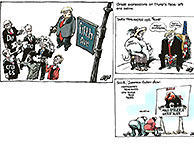




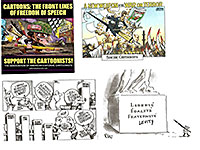
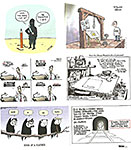
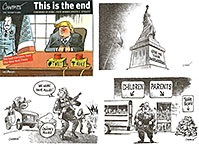
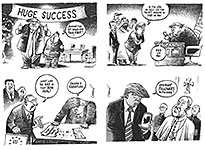
1.jpg)
2.jpg)
3.jpg)
4.jpg)
5.jpg)
6.jpg)
7.jpg)
8.jpg)
9.jpg)
1.jpg)
2.jpg)
3.jpg)
4.jpg)
5.jpg)
6.jpg)
7.jpg)
8.jpg)
9.jpg)
10.jpg)
11.jpg)
12.jpg)
13.jpg)

14.jpg)
15.jpg)
16.jpg)
17.jpg)
18.jpg)
19.jpg)
20.jpg)
21.jpg)
22.jpg)
23.jpg)
24.jpg)
25.jpg)
26.jpg)


27.jpg)
28.jpg)
29.jpg)
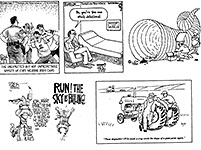
30.jpg)
31.jpg)

32.jpg)
33.jpg)
34.jpg)
35.jpg)
36.jpg)
1a.jpg)
2.jpg)

